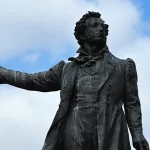
09.12.2022
Alexander Sergeyevich Pushkin is a man of world literature. He wrote many works that made him famous and loved by many generations of admirers of his talent.
It is safe to say that modern Russian literary language began with the poet Alexander Pushkin. It was he who managed to combine in his works all the best of national and world literature of the period. It was he who brought together the literary language and the original vernacular. Pushkin praised the richness, expressiveness, flexibility of Russian language, which allows any talented writer to create true masterpieces. And at the same time, in his works he tried to express himself as accurately and clearly as possible, without the secondary. It is thanks to the talent of Pushkin, the Russian language has risen to the level of the great national and world language.
“The Tale of Tsar Saltan” was written by Pushkin in 1831. He drew the plot from the fairy tales told by his nanny, Arina Rodionovna. It was the speech of the nanny, her tales and jokes became for Pushkin an inexhaustible treasure trove of Russian national poetry. It was she who told Alexander Sergeyevich tales “Feet knee-deep in gold, hands elbow-deep in silver”, “The singing tree, the living water and the chattering bird”, and also “The Tale of Three Queens, Sisters-in-Law”.
Pushkin drew the main motifs of his future masterpiece from these tales: the conversation of three sisters overheard by the tsar, the birth of a miraculous baby, a plot by envious women resulting in the queen and her child being thrown into water in a barrel, the wondrous wonders of a distant sea island, 30 knights guarding that island, etc. However, Pushkin’s sources are not exhausted by Russian folklore alone. The story of the slandered mother and the miraculous children is very popular and can be found in fairy tales all over the world.

Often these motifs have received a literary treatment. So Pushkin was certainly familiar with the tale of the French Baroness d’Onois, The Princess Belle Etoile, which tells of a marvelous maiden with a star, and also with the Lawyer’s Tale from the Canterbury Tales, which deals with the slandered daughter of the emperor who is sent in a boat to the waves.
There are few proper names in the tale. These are Saltan, Guidon, the Swan Princess and Babarikha’s sister-in-law. Pushkin refers to the rest of the characters simply as the tsarina, the weaver, the cook, etc.
Saltan is obviously the lubonic “Tsar Sultan,” a character well known to the Russian people since the endless wars with the Turks. Everyone knew that somewhere far away there was a mighty kingdom ruled by “Tsar Saltan.
Gvidon is a name borrowed from the biblical cycle “About Bove the Queen,” which is a reworking of a European romance of chivalry. Guidon is the name of Bova’s father in this cycle.
The Princess Swan is entirely a child of Pushkin’s authorial imagination. The image of the Princess Swan was born under the influence of such characters as Vasilisa the Wise or Sophia the Wise and the French princess Belle Etoile.
Baba Babarikha. The poet takes this character, possibly, from Russian proverbs, which feature a certain Babariha, “who sits on a rock on the blue sea, a luminous pan holding a burning pan to burn ailments.
You may also like:

09.12.2022
Basic facts about Pushkin that everyone should know

09.12.2022
Where did Pushkin take the heroes for his works and who did he write about in his books?

09.12.2022
Alexander Sergeyevich Pushkin: The Life of a Russian Man

09.12.2022
Interesting facts about Alexander Sergeyevich Pushkin
